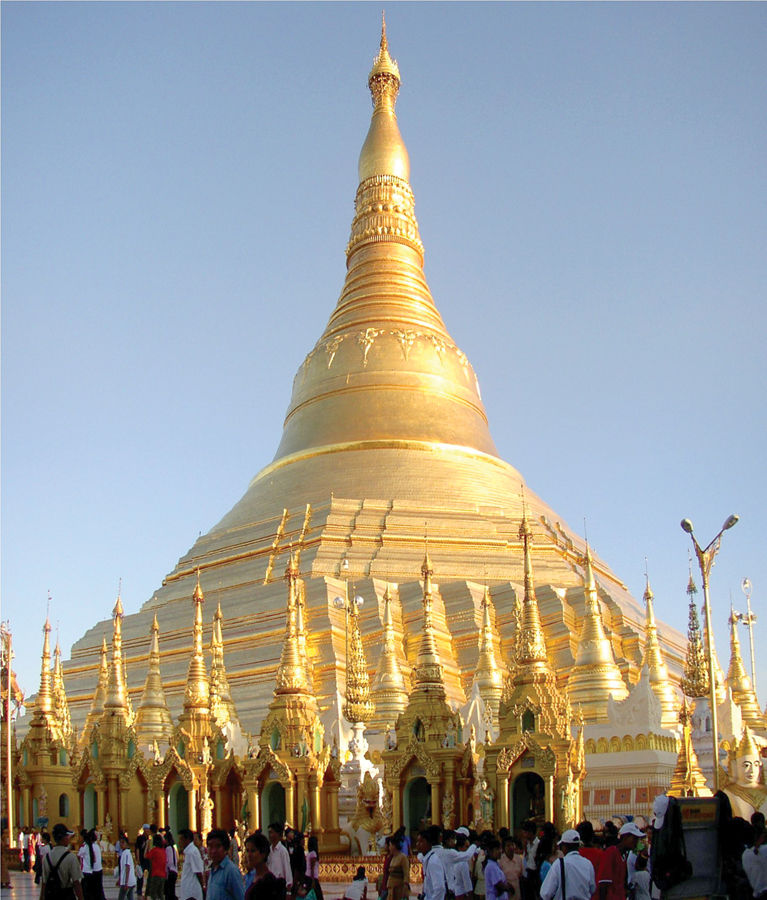The green flash I saw most recently was not the winking color magic of sun dropping behind blue sea at sunset, which originally inspired the name of this column. Instead, it was well past sunset when we saw the jeweled
The green flash I saw most recently was not the winking color magic of sun dropping behind blue sea at sunset, which originally inspired the name of this column. Instead, it was well past sunset when we saw the jeweled wink of an enormous diamond embedded in the golden dome of the Shwedagon Pagoda in Rangoon, Burma (also called Myanmar, but never by Burmans — discounting the military junta and cronies).
When viewed from a certain area marked on the marble floor of the amazing temple complex, the jewel appeared emerald green. Stepping forward or back a few paces, the color appeared to change, giving the illusion of sapphire or ruby. Then, forward again to diamond brilliance.
Visitors, including myself, emitted tones of wonder at the varying phenomena observed on the warm October evening. My husband and I, with newly-made friends in our tour group, climbed the wide, teak steps and walked over the smooth tiles barefoot, escorted by our fine guide. This grand finale followed a farewell dinner and cultural show staged on a floating barge built with twin hulls to resemble a mythical bird.
The Shwedagon and its surrounding golden, onyx and carved teak complex has been a site of great wonder and worldly wealth in what used to be the rich country of Burma, as well as a symbol of spiritual force built on even older stupas predating the fifth century. For centuries it has been a Buddhist pilgrimage site. The Shwedagon is a treasure house of gold and jewels, a reliquary for the great Gautama Buddha’s hairs, a place believed to be home to magical “weizzas” (tantric wizards), and a beacon for mankind lighting the path to Nirvana (Nibbana in the ancient Pali language of Burma).
The shining topknot and dome are visible by day and night from every part of Rangoon (Yangon, as above), still considered the capital of Burma by the general populace, and discounting the “new capital” half way between Rangoon and Mandalay that was built somewhat secretively for the military generals and elite to reside in, living the good life off the spoils of Burma’s natural resources and minerals. (Stolen!)
But beyond this site and the many other amazing treasures — both manmade and natural — seen during our trip through Burma to retrace my family history dating back past Burmese “independence” to Colonial times, the true treasure of Burma which emerged for me was the underlining connection perceived between Burmese and Polynesian culture, and in particular, Hawaiian culture.
We could start with Hawaii’s welcoming aloha, which parallels the Burmese “Min gala ba” (welcoming hello).
As a child in Mandalay, I heard a tale of a golden people who sailed away in a magical bird boat to disappear forever. This captured my imagination, but over the years I forgot about it. That is, until some years ago when I attended a lecture on the origins of the Polynesians who became Hawaiians, which led westward back over the Pacific and other oceans to a series of navigational migrations over thousands of years stemming from Southeastern Asian islands.
When the new DNA studies made it possible for scientists to study the women’s mitochondrial DNA of all Polynesians and match them as cousins with women of the Sino-Tibetan plateau, which, with the shifting borders over the ages includes Burma, Thailand, Tibet and northern China, I became excited.
When the DNA studies were published that proved the information incontestably, I felt not only thrilled by perceived cultural connections, but stunned. A memory of the childhood story resurfaced. My mind shuttled between my chosen home on the island of Kauai and my parent’s birth home, the Burma jewel of British India times.
The connections weave a kapa (tapa) of cultural similarities: the gentleness of manner and protocol with strong spiritual belief; the honoring of the land and connection with it, such as with the aina (earth); the volcanic aspect of the land, also red with high iron content; the trees, plants and flowers — acacia, mulberry varietals, poinciana, frangipani (plumeria), spider lilies, gingers, and kalo (taro), called “sweet potato” and grown as white, yellow and purple varieties; the proven plant medicines; the conch shell trumpets and ceremonies related to the cosmos, the spin and seasons of the world, sun, moon and other planets, and stars; the red and gold spiritual and royal colors; the refined excellence at woodcarving and the weaving prepared plant materials into useful, beautiful items. Then, the connection with water and boats (the great Irrawaddy River and its tributaries, as well as bays and harbors), and, of course, the double-hulled, mythical Karaweik, or bird boat.
Exploring these connections plus further ones, and a sense of unity in this now developing global “one world” in which we live is one of the treasures I will keep from this journey to the Golden Land, and my personal pilgrimage to family history places retraced, revisited and photographed for my children and grandchildren, and future descendants.
Dawn Fraser Kawahara, author and poet, regularly instructs on the topics of history and Hawaiian culture for visitors to Kauai through Hawaii Pacific University’s “Road Scholar” program through Pacific Islands Institute. The writer is at work completing her second memoir, based on recent travels described and the Burma of pre- and post-World War II times, toward Burmese independence.


